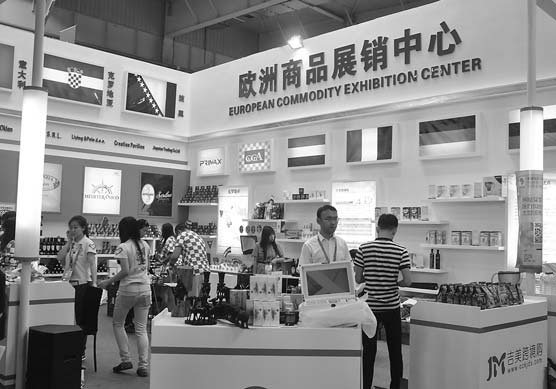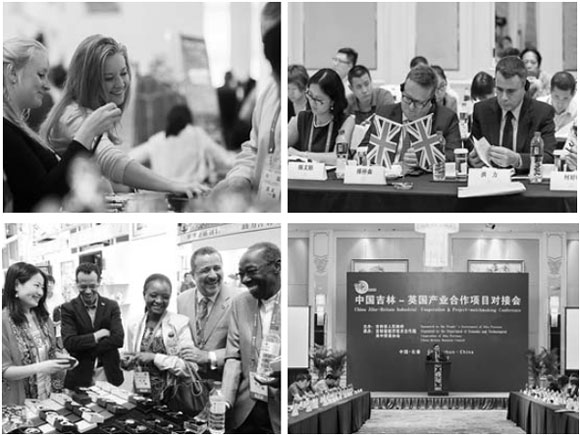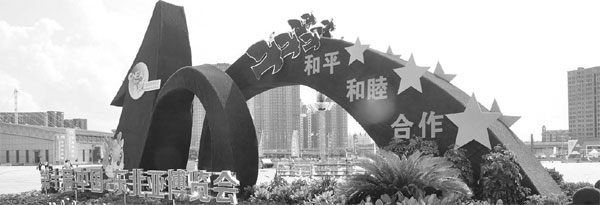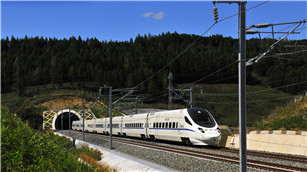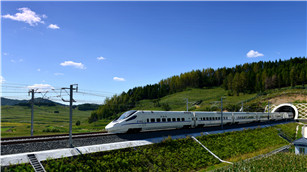Northeast Asia promotes trade links
By Zhong Nan and Liu Mingtai
( China Daily )
2015-10-20
|
European commodities are displayed at the expo.[Photo Provided to China Daily] |
|
Delegates from Northeast Asia and Europe attend the expo. [Photos Provided to China Daily] |
The China-Northeast Asia Expo provided a perfect meeting place for entrepreneurs and officials, and helped attract investment and interest to the country's northeastern provinces, Zhong Nan and Liu Mingtai report from Changchun.
Northeast China's Jilin province will undertake more regional connectivity and trade and cultural exchange activities with the United Kingdom and other European markets via the platform of the China-Northeast Asia Expo, to promote its global influence and earning ability.
The expo has provided a platform for countries to put their export growth on a firmer footing via decisive measures, such as signing bilateral or multilateral free trade agreements or launching international trade and investment fairs.
The event, launched by the Chinese government, started since 2005. This year, it began from Sept 1 to 6 in Changchun, the provincial capital, and generated 220 billion yuan ($35 billion) in investment capital, and 325 contracts with parties from across the world.
More than 50 British companies, including the automaker Jaguar Land Rover, tea producer Twinings and retailer Marks and Spencer, brought products and representatives to the expo. They received a warm welcome from consumers, not only in the province but across the Northeast Asia region.
The six-nation region - China, Russia, Mongolia, the Democratic People's Republic of Korea, the Republic of Korea and Japan - represents a market with a population of 1.7 billion and more than 20 percent of the world's GDP.
Chen Weigen, director of the expo's executive committee, said cooperation in Northeast Asia has gained tremendous ground, and the expo had stimulated business in sectors such as logistics, tourism, aviation, shopping, food and culture between the region and other countries.
In addition to its regular members, the expo also welcomed a number of other countries, especially those with developed markets, Chen said.
More than 10,000 representatives of international companies, including purchasing agents, from 111 countries and regions participated in the expo. They sought to either buy products made in the region or negotiate business deals with buyers and clients from other nations.
Official data show trade contracts worth $801 million were clinched at this year's event. The World Purchaser Fair, part of the expo, alone saw deals worth $132 million signed in less than four hours during the event. More than 55 companies from countries such as the United Kingdom, the Netherlands, the United States, Russia, India and Malaysia were among the signatories.
Chen said both Chinese and overseas companies showed interest in products related to high-end manufacturing, garments, chemicals, agriculture, pharmaceuticals and electronics.
Stephen Phillips, CEO of the China-Britain Business Council, said China is promoting the modern services industry and undergoing a boom in industrial upgrades to develop more-advanced and greener products, and British companies are keen to deploy more resources and manpower to the province to develop sectors such as agricultural product processing, energy saving and modern services and equipment during the next five years.
Founded in 1953, the council is responsible for promoting Sino-UK cooperation in trade, investment, innovation and technology. It has 13 regional offices across China.
Sino-UK trade volume
The trade volume between China and UK reached $50.6 billion between January and August, and British companies have invested $400 million in 228 projects in China, a rise of 18.75 percent year-on-year. China's outbound direct investment inflow to the UK was $210 million, growing 10.5 percent from the same period a year earlier.
China signed contracts for new products in the UK worth $1.17 billion in the first eight months of the year, an impressive rise of more than 234 percent from the same period a year earlier, according to data released by the Ministry of Commerce earlier this month.
Jiang Chaoliang, the governor of Jilin, said work to ensure the expo's success began in January, with a strong focus on increasing the efficiency and effectiveness of investment pitches. Special attention was paid to the services sector, and the collection of information on businesses, the acceleration of industrial upgrades, the promotion of cooperation, and projects in strategic and emerging sectors.
The organizers arranged 35 large-scale business promotion meetings and events, as well as 290 specialized and regional project promotion meetings. About 9,800 entrepreneurs and officials discussed 2,600 issues during the meetings.
"The platform provided by the China-Northeast Asia Expo will help China improve investment, trade, financial cooperation, infrastructure development and policy understanding with the UK and other European nations along the Belt and Road Initiative," Jiang said.
The Silk Road Economic Belt and the 21st Century Maritime Silk Road initiatives were proposed by President Xi Jinping in 2013, with the purpose of rejuvenating the two ancient trade routes and further opening markets for Chinese companies.
Jiang said China's "going global" strategy - exporting mature industries, diversification of its foreign exchange reserves and investing overseas - is already being implemented along the proposed belt and road route, and its progress will create a new landscape for the opening-up of Northeast China and its global trade partners.
Eager to increase its trade volume with developed markets, Jilin plans to open more air and sea links with the UK and Europe to seek new points of market growth.
Well-positioned geographically
Jilin is particularly well-positioned geographically to develop a modern logistics industry, with 16 border ports between China and Russia and China and the DPRK, plus two international airports and two inland railway ports.
For example, Fangchuan village in Hunchun, in the east of the province, is just 15 kilometers from the Sea of Japan. The mouth of the Tumen River, which feeds into the sea, is the closest point between China and Russia, the east coast of the Korean Peninsula, Japan and the DPRK.
Wang Shouchen, deputy director of the Jilin Provincial People's Congress, said officials are also planning to work with selected ports in Russia and the DPRK to develop shorter maritime routes to ship goods to European ports, such as Liverpool and Portsmouth in the UK, Rotterdam in the Netherlands and Hamburg, Germany, via the Northeast Passage in the Arctic Ocean.
Specially designed cargo vessels laden with Chinese goods will leave Russia's Zarubino Harbor or the DPRK's Rajin Port on a 30-day journey to European destinations via the passage, which could cut shipping times between Northeast Asia and European ports by about a third.
"Developing combined transport by rail, sea, road and other infrastructures is a practical way of establishing a flexible transportation network from Jilin to Europe, which will certainly improve and diversify regional economic growth," Wang said.
He added that air cargo services from Changchun Longjia International Airport to major cities in Germany, Russia, Mongolia and Japan will be available soon, and will ferry high-end and high-tech products between consumers and manufacturers on both sides.
Jilin is also preparing to launch international rail freight services from Changchun to Ulaanbaatar, the capital of Mongolia, and major cities in Russia over the next three years.
With its mature equipment-manufacturing industry and high levels of technical expertise, Jilin is considered one of China's major industrial bases, with the automobile sector its pillar industry.
Last year, Changchun's First Automotive Works Group sold more than 3 million vehicles, accounting for 13 percent of China's total auto sales.
Official data show that last year Jilin's foreign trade rose by 2.1 percent year-on-year, while foreign direct investment into the province rose by more than 13 percent.
The province has already developed more than 10 large logistics parks, including the Changchun Xinglong Free Trade Zone, which houses facilities built by manufacturers, warehouse developers and delivery companies, including Zhejiang Transfar Co, Global Logistic Properties Ltd and SF Express Co.
"Like China's Belt and Road Initiative, Russia is also raising capital to develop its Far East region, while the Republic of Korea is promoting its Eurasian initiative to further connect with mature markets in Europe," said Ling Ji, director-general of the department of Eurasian affairs at the Ministry of Commerce.
Ling said the expo can help countries such as these to obtain technologies, products and investment, such as equipment related to infrastructure development, logistics services, high-speed railways and telecommunications that are necessary to achieve their goals, not only in the region, but also in Central Asia and Europe.
Visa procedures eased
To further enable the movement of people and the exchange of innovative ideas between two major economies, the British government has simplified the visa application procedure for Chinese tourists and business travelers to reduce unnecessary barriers to further interaction and mobility.
Fang Aiqing, vice-minister of commerce, said companies on both sides have been encouraged to use their own currencies to seal deals and build e-commerce platforms to save on operating and trading costs, as well as establishing closer cooperation between customs authorities to simplify clearance procedures.
"The expo has brought about a decade of new development factors. The expo's changing themes are inspiring," Fang said. "Annual themes, such as regional connectivity, the promotion of the private sector and diversified bilateral or multilateral cooperation, have not only boosted business and prosperity in the region, they have also met the new growth demand of nations in other parts of the world."
Cai Jin, vice-president of the China Federation of Logistics and Purchasing in Beijing, said the accelerated reform of State-owned enterprises, a readjustment of industrial structures and service-trade upgrades will result in the growth of Jilin's foreign trade volume, and the whole northeastern region is projected to grow steadily in the second half.
"Even though building a logistics network in the northeastern Asian region has been helpful in improving Jilin's economy, logistics and e-commerce, companies across China should be aware that they have to focus overwhelmingly on expanding their export channels," Cai said.
"It would also prove profitable to establish more overseas logistics facilities and sorting centers in countries, including the UK, Germany, the Republic of Korea, Japan, Singapore and the US, from which to operate export businesses to China, while the market still has low levels of competition and demand is fairly high."
|
Delegates attend the open ceremony of the expo. [Photo Provided to China Daily] |
|
A garden in Changchun, capital city of Jilin province, represents the expo's goal of achieving "peace, harmony and cooperation". [Photo Provided to China Daily] |

